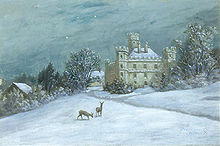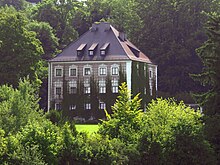Berg Castle (Bavaria)


The mountain palace is situated on the eastern shore of Lake Starnberg on the territory of the municipality mountain in the Bavarian district of Starnberg . It became known through the unexplained death of King Ludwig II.
history
Berg Castle was built on land that Elector Ferdinand Maria acquired from the Horwarth family in 1676. The heyday was in the time of Max Emanuel and Karl Albrecht . Magnificent festivals and hunts took place.
From 1849 to 1851, King Maximilian II had the palace extensively rebuilt by Eduard Riedel . He bought land and the castle received four towers and battlements in neo-Gothic style. Later King Ludwig II added the tall fifth north tower, which he called "Isolde". In 1853 Max II had a small port built specially.
Ludwig II used the castle as a summer residence. Every year on May 11th, he moved his seat to Berg Castle and conducted his government business from there. A telegraph line was even set up between Berg and Munich for this purpose. The king spent most of his life at Berg Castle, it was here that he forged his building plans, and it was here that he received guests such as the composer Richard Wagner .
In 1868 the Russian tsarina Maria Alexandrovna came to Berg at the invitation of the king. Ludwig let her live in the castle for the time of her visit and had it lavishly furnished for the occasion. Otherwise, by Ludwig's standards, the castle was kept rather simple.
In the park, which was designed by the predecessors according to the respective fashions, from the French to the English garden , Ludwig had the Moorish kiosk set up, which Franz von Seitz had actually built for the winter garden on the roof of the Munich residence . In 1876 he had a small chapel built.
On June 12, 1886, Ludwig II was brought to Berg Castle after his incapacitation. Neither of them returned alive from a walk with the doctor Prof. von Gudden . The causes of death have not yet been clarified. According to the official version, he drowned on June 13, 1886 in Lake Starnberg not far from the castle, which is remembered today by the votive chapel and in front of it a wooden cross in the shallow bank water near Berg.
After the death of the king, the castle was declared a museum and a monument in 1939 because it had not been changed since the death of Ludwig II and it was given cultural and historical importance. It has belonged to the Wittelsbach Compensation Fund since 1923 .
The castle was used by the American military immediately after the Second World War . The war-related damage from World War II - especially to the corner towers - was repaired from 1949 to 1951 and the castle was fundamentally renovated after the interior was badly damaged by water damage caused by the Americans. The water had destroyed the listed building so thoroughly that it was even threatened with demolition. During the renovation, the corner towers, battlements and the neo-Gothic stucco facade were torn down and the original external condition was restored by means of painted baroque window frames. Nothing remained of the interior during the time of Ludwig II.
The castle chapel was not changed. After the restoration, the palace served as the main residence of Albrecht Herzog von Bayern until his death in 1996 and since then his son Franz von Bayern's summer residence. It cannot be visited.
literature
- Gerhard Schober: District of Starnberg (= Bavarian State Office for Monument Preservation [Hrsg.]: Monuments in Bavaria . Volume I.21 ). 2nd Edition. Munich / Zurich 1991, p. 40-45 .
Web links
Coordinates: 47 ° 58 ′ 12 ″ N , 11 ° 21 ′ 5 ″ E



